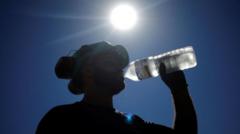With climate change leading to more frequent and severe heatwaves, the World Health Organization (WHO) and the World Meteorological Organization (WMO) have issued a crucial report emphasizing the urgent need for better protection of workers from heat stress. Millions are at risk, particularly those in labor-intensive jobs such as construction and agriculture, prompting a call for collaboration amongst governments, employers, and workers to devise effective adaptation strategies.
Rüdiger Krech, WHO’s director of environment, climate, and health, described the findings as a "wake-up call," stressing that prolonged exposure to temperatures exceeding 38 degrees Celsius significantly raises the risk of severe heat-related illnesses like strokes and kidney failure. The report marks the first specific focus on heat stress in occupational settings since 1969.
The numbers paint a concerning picture: productivity declines by 2% for every degree above 20 degrees Celsius, and with heatwaves becoming more commonplace, particularly in Europe, adapting work environments is increasingly critical. The last decade has recorded unprecedented temperature spikes, while 2024 is projected to be the hottest year on record. Extreme heat is no longer an anomaly; in many regions, such as parts of Europe, temperatures now often reach or surpass 40 degrees Celsius, with African and Middle Eastern areas seeing even higher figures.
Moreover, the report highlights correlations between rising heat levels and increased workplace accidents. A study during Europe’s 2023 heatwave revealed that incidents spiked by 7% in Switzerland when temperatures surpassed 30 degrees Celsius. The phenomenon is attributed to decreased focus and poor rest caused by extreme heat conditions.
Many European nations are beginning to respond with proactive measures. For instance, Italy recently implemented an emergency decree to protect workers from extreme temperatures. Similarly, Swiss authorities have paused construction activities during heatwaves—a move applauded by unions advocating for worker safety.
The implications extend beyond the workplace; vulnerable populations including the elderly and young children also face profound health risks during heatwaves. Schools are adapting too, with Germany instituting "Hitzefrei" policies to dismiss classes during extreme heat, a luxury not often afforded now as high temperatures become routine.
Krech emphasizes the need for well-planned collaboration across sectors for effective adaptation, including considerations for school uniforms that withstand heat. He cautioned against negligence, arguing that failure to invest in necessary adaptations could lead to even greater losses in productivity as worker health declines under the strain of extreme temperatures.
In conclusion, the WHO's report serves as a stark reminder of the widening impact of climate change on health and productivity, urging immediate action to protect vulnerable workers and societies alike in the face of rising temperatures.
Rüdiger Krech, WHO’s director of environment, climate, and health, described the findings as a "wake-up call," stressing that prolonged exposure to temperatures exceeding 38 degrees Celsius significantly raises the risk of severe heat-related illnesses like strokes and kidney failure. The report marks the first specific focus on heat stress in occupational settings since 1969.
The numbers paint a concerning picture: productivity declines by 2% for every degree above 20 degrees Celsius, and with heatwaves becoming more commonplace, particularly in Europe, adapting work environments is increasingly critical. The last decade has recorded unprecedented temperature spikes, while 2024 is projected to be the hottest year on record. Extreme heat is no longer an anomaly; in many regions, such as parts of Europe, temperatures now often reach or surpass 40 degrees Celsius, with African and Middle Eastern areas seeing even higher figures.
Moreover, the report highlights correlations between rising heat levels and increased workplace accidents. A study during Europe’s 2023 heatwave revealed that incidents spiked by 7% in Switzerland when temperatures surpassed 30 degrees Celsius. The phenomenon is attributed to decreased focus and poor rest caused by extreme heat conditions.
Many European nations are beginning to respond with proactive measures. For instance, Italy recently implemented an emergency decree to protect workers from extreme temperatures. Similarly, Swiss authorities have paused construction activities during heatwaves—a move applauded by unions advocating for worker safety.
The implications extend beyond the workplace; vulnerable populations including the elderly and young children also face profound health risks during heatwaves. Schools are adapting too, with Germany instituting "Hitzefrei" policies to dismiss classes during extreme heat, a luxury not often afforded now as high temperatures become routine.
Krech emphasizes the need for well-planned collaboration across sectors for effective adaptation, including considerations for school uniforms that withstand heat. He cautioned against negligence, arguing that failure to invest in necessary adaptations could lead to even greater losses in productivity as worker health declines under the strain of extreme temperatures.
In conclusion, the WHO's report serves as a stark reminder of the widening impact of climate change on health and productivity, urging immediate action to protect vulnerable workers and societies alike in the face of rising temperatures.



















